The Einstein from Schaffhausen
By Michael Friedberg
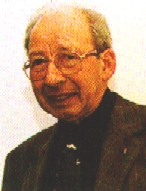 Kurt Klaus, a self-effacing man with a certain professorial
look about him, may be a Swiss national treasure. He certainly is for
International Watch Company in Schaffhausen, Switzerland, where he serves as
their master watchmaker. They sometimes call him Einstein at the factory. He
does look like the quintessential inventor --more than a bit of genius, mixed with a sense of
analytic precision but an ability to dream.
Kurt Klaus, a self-effacing man with a certain professorial
look about him, may be a Swiss national treasure. He certainly is for
International Watch Company in Schaffhausen, Switzerland, where he serves as
their master watchmaker. They sometimes call him Einstein at the factory. He
does look like the quintessential inventor --more than a bit of genius, mixed with a sense of
analytic precision but an ability to dream.
Klaus created the DaVinci perpetual calendar in 1985. The
DaVinci's coordinated perpetual calendar plate then was considered
revolutionary. For the first 5 years of Lange's reincarnation, he spent a week each month in
Glashuette, assisting in the development of their movements. For the past 4 1/2
years, Klaus headed the design team for IWC's brand new in-house movement, the
Calibre 5000.
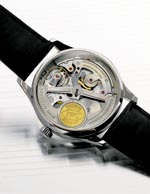 To
understand Kurt Klaus, one needs to understand his inventions. To learn more
about Klaus' invention of the perpetual calendar for the DaVinci, click
here.
This construction for the first time allowed all calendar functions to be set at
once by the crown --that is, setting the current date sets the month, year and
moon phase as well. Some 15 years later, Klaus has done it again with IWC's
totally new, in-house movement, the Calibre 5000, which generally is described
in a prior article (click
here). While using the best of tradition, the Calibre
5000 contains many innovations -- it is among the first automatic movements with
lengthy autonomy and the only one that stops the balance towards the end to avoid
isochronism error.
To
understand Kurt Klaus, one needs to understand his inventions. To learn more
about Klaus' invention of the perpetual calendar for the DaVinci, click
here.
This construction for the first time allowed all calendar functions to be set at
once by the crown --that is, setting the current date sets the month, year and
moon phase as well. Some 15 years later, Klaus has done it again with IWC's
totally new, in-house movement, the Calibre 5000, which generally is described
in a prior article (click
here). While using the best of tradition, the Calibre
5000 contains many innovations -- it is among the first automatic movements with
lengthy autonomy and the only one that stops the balance towards the end to avoid
isochronism error.
I had the pleasure of recently spending time with Herr Klaus
and being taught by him (at least as much as this amateur student can absorb)
about how the Calibre 5000 works. More importantly, it taught me a great deal
about his philosophy of watchmaking and, in a sense, IWC's philosophy.
In fact, Klaus began our discussions by telling me that the
Calibre 5000 makes a statement -- he said that it is "not just a
construction" and instead the movement reflects a "philosophy" of
watchmaking. There is a theme behind each of the decisions that was made when
developing the movement. To Klaus, the Calibre 5000 combines new technology with
old techniques.
That is not surprising, considering that Kurt Klaus has been
at IWC for 43 years. He, more than anyone else, must carry on the tradition.
Albert Pellaton, perhaps IWC's greatest technical director, was Kurt Klaus'
master teacher. Pellaton taught Klaus that innovation is inherent in that tradition, but
there must be a respect for classic principles at the same time.
The Calibre 5000 embodies these premises, even down to its
screws. Many companies use heat-treated, blued screws as a mark of quality.
Klaus vetoed them in IWC's new movement. To him, a screw-head can be blued
inexpensively, but a polished screw-head takes more time and is more beautiful.
More importantly, the great IWC pocket watch movements --the Calibres 95, 97 and
98, all starting in the 1930s-- never had blued-screws. These were nickel-plated
calibres with white screws. The Calibre 5000, a pocketwatch size movement,
would embody that same tradition.
Yet Kurt Klaus believes that a tradition of innovation itself
requires innovation. He believes that the Calibre 5000 is the first
series-produced automatic
7-day movement. That entailed several requirements and further developments.
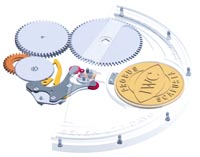 A
7-day automatic or self-winding movement requires more space. The mainspring is
longer and the barrel is bigger. To wind the watch quickly, a larger oscillating
weight (that is, rotor) is required. Unlike other companies that have 7-day
manual wind movements, which usually require lengthy winding, an automatic
movement after a start can wind itself. The end result of this would be perhaps
the world's largest automatic watch movement.
A
7-day automatic or self-winding movement requires more space. The mainspring is
longer and the barrel is bigger. To wind the watch quickly, a larger oscillating
weight (that is, rotor) is required. Unlike other companies that have 7-day
manual wind movements, which usually require lengthy winding, an automatic
movement after a start can wind itself. The end result of this would be perhaps
the world's largest automatic watch movement.
The
need to produce a large movement in turn resulted in further consequences. To
Klaus, a "big movement needs a big balance". The primary reason for
this is aesthetics. In comparison, he told me that the Lange One,
which is a relatively large movement, has a smaller balance due to the number of
complications, especially the oversized date.
IWC's new large, slow beat movement in turn would use a Breguet
overcoil. In fact, Klaus said that a small balance, high-beat
movement in a wristwatch does not need a Breguet overcoil --its accuracy over
time, in actual use, would be about the same regardless. But a large movement is
a different story; according to Klaus, the overcoil becomes increasingly
important. The only problem is that, in Klaus' opinion, a Breguet overcoil
should not be made by machine and must be made by hand. Every hairspring
requires a different bend and there is no empirical way to judge that. It is a
difficult skill to learn; IWC currently employs three "regleuse".
Their skill requires experience, as well as a dexterity and patience best
suited, in Klaus' opinion, for women. "You need good fingers", Klaus
told me and added that a good regleuse can command the same salary as the best
watchmaker.
At that point in our discussions, I had learned that the goal
of a 7-day automatic resulted in the following primary design decisions:
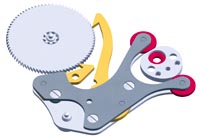 Of course, each of these decisions
prompted still further
decisions. The winding system adopted Pellaton's ingenious Cal. 85 invention,
with its heart-shaped cam. This simple and ingenious system has been praised for
its efficiency and reliability. Instead of having a series of gears connect the
rotor to the barrel wheel, a cam oscillates between two rollers (depicted at
right in red). This energy is transported to two clicks (depicted in yellow)
which ratchet against the barrel teeth, winding the the mainspring inside the
barrel.
Of course, each of these decisions
prompted still further
decisions. The winding system adopted Pellaton's ingenious Cal. 85 invention,
with its heart-shaped cam. This simple and ingenious system has been praised for
its efficiency and reliability. Instead of having a series of gears connect the
rotor to the barrel wheel, a cam oscillates between two rollers (depicted at
right in red). This energy is transported to two clicks (depicted in yellow)
which ratchet against the barrel teeth, winding the the mainspring inside the
barrel.
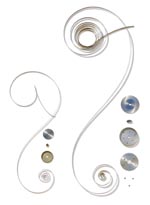 The
movement's lengthy autonomy
required either double barrels or a huge barrel with a lengthy mainspring --the
design team chose the latter, on the principle that simplicity should enhance
reliability. However, the decision to use a huge
barrel required further decisions. The end of the mainspring glides inside the
barrel or, as Klaus stated, the barrel is "used" by the friction of
gliding, which means that the inside of the barrel wall wears down gradually
over years of use as the mainspring bridal slides along from its wound force. A bigger mainspring creates more "use" and more danger to the
barrel. The Calibre 5000's mainspring and barrel are depicted right, in
comparison to a normal spring and barrel.
The
movement's lengthy autonomy
required either double barrels or a huge barrel with a lengthy mainspring --the
design team chose the latter, on the principle that simplicity should enhance
reliability. However, the decision to use a huge
barrel required further decisions. The end of the mainspring glides inside the
barrel or, as Klaus stated, the barrel is "used" by the friction of
gliding, which means that the inside of the barrel wall wears down gradually
over years of use as the mainspring bridal slides along from its wound force. A bigger mainspring creates more "use" and more danger to the
barrel. The Calibre 5000's mainspring and barrel are depicted right, in
comparison to a normal spring and barrel.
 Albert Pellaton had developed a barrel for IWC's Calibre 853 in the late
1950s using aluminum oxide, an aluminum alloy treated with electric oxidation
and which had the same hardness as a ruby. It had worked flawlessly, with easy
glide of the mainspring and virtually no wear (in contrast, earlier Cal. 852
barrels are routinely replaced with Cal. 853 barrels during servicing). IWC's
new Calibre 5000 would have an aluminum oxide barrel. But that, in turn,
required a separate barrel head. It was very difficult to mill teeth in aluminum
oxide, so brass was used and screwed on the top of the barrel.
Albert Pellaton had developed a barrel for IWC's Calibre 853 in the late
1950s using aluminum oxide, an aluminum alloy treated with electric oxidation
and which had the same hardness as a ruby. It had worked flawlessly, with easy
glide of the mainspring and virtually no wear (in contrast, earlier Cal. 852
barrels are routinely replaced with Cal. 853 barrels during servicing). IWC's
new Calibre 5000 would have an aluminum oxide barrel. But that, in turn,
required a separate barrel head. It was very difficult to mill teeth in aluminum
oxide, so brass was used and screwed on the top of the barrel.
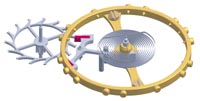 While the
winding system and the barrel were based on IWC's Cal. 85 designs, as originally
developed by Albert Pellaton during the late 1940s through the 1950s, the
escapement of the new movement would be based on IWC's Calibre 89. This
ultra-reliable manual movement was introduced by IWC shortly after World War II
and continued for more than 40 years. Klaus wanted to use what he considered the
"best of IWC". IWC's famous Mark XI watch used the Calibre 89 and the
military issue Mark XI's were all chronometers. According to Klaus, if was good
enough for pilot watches, it was good enough for the new Calibre 5000.
While the
winding system and the barrel were based on IWC's Cal. 85 designs, as originally
developed by Albert Pellaton during the late 1940s through the 1950s, the
escapement of the new movement would be based on IWC's Calibre 89. This
ultra-reliable manual movement was introduced by IWC shortly after World War II
and continued for more than 40 years. Klaus wanted to use what he considered the
"best of IWC". IWC's famous Mark XI watch used the Calibre 89 and the
military issue Mark XI's were all chronometers. According to Klaus, if was good
enough for pilot watches, it was good enough for the new Calibre 5000.
 The
Calibre 5000 therefore adopted the pocketwatch principle of a larger escapement
and correspondingly larger balance. However, because Klaus considered the Cal.
89 escapement as difficult to regulate, he took the regulator design from the
Cal. 8541. The regulation still does not appear simple. The screwed balance was
used partially for appearance, but it allows first adjustments (such as if the
watch initially is one minute fast) and positional adjustment. Eccentric pins,
not screws, on the regulator are primarily used to adjust beat. The spring must
be perfectly centered.
The
Calibre 5000 therefore adopted the pocketwatch principle of a larger escapement
and correspondingly larger balance. However, because Klaus considered the Cal.
89 escapement as difficult to regulate, he took the regulator design from the
Cal. 8541. The regulation still does not appear simple. The screwed balance was
used partially for appearance, but it allows first adjustments (such as if the
watch initially is one minute fast) and positional adjustment. Eccentric pins,
not screws, on the regulator are primarily used to adjust beat. The spring must
be perfectly centered.
 Unlike
most other movements, the Calibre 5000 has a power reserve with a
mechanism to stop the balance, as the spring becomes close to fully unwound. The
amount of winding goes through a gear train and as the indicator approaches 7
days of unwind it triggers a pin on a wheel. A "differential stop
spring" then serves as a brake on the balance. When I asked whether any
other watch incorporated such a clever design, Herr Klaus said only one:
"the Lange Pour le Merit, but that differential stop spring stops the
cage of the tourbillon". When I asked whether stopping the balance could be
bad for a watch, as some other companies contend, he just shook his head,
"I've never seen danger in 50 years" and pointed out the reliability
of IWC's Calibre 89.
Unlike
most other movements, the Calibre 5000 has a power reserve with a
mechanism to stop the balance, as the spring becomes close to fully unwound. The
amount of winding goes through a gear train and as the indicator approaches 7
days of unwind it triggers a pin on a wheel. A "differential stop
spring" then serves as a brake on the balance. When I asked whether any
other watch incorporated such a clever design, Herr Klaus said only one:
"the Lange Pour le Merit, but that differential stop spring stops the
cage of the tourbillon". When I asked whether stopping the balance could be
bad for a watch, as some other companies contend, he just shook his head,
"I've never seen danger in 50 years" and pointed out the reliability
of IWC's Calibre 89.
Kurt Klaus considers the Calibre 5000 as having the best of
all worlds: a combination of new technology but using old techniques. He did not
want to make something new just to make something new, and he wanted the
movement to have practical utility. When the first prototype was made, he wound
it slightly, enough to get the watch started without the tedious stem winding of
most 7-day manual wind watches, and then wore the watch over a weekend. When the
work-week started, he left the watch in a drawer. The next weekend, he took the
watch out --its timekeeping was still perfect and he wore it again.
He views this as practical and innovative, but based on IWC's
tradition. While he says that Lange makes a very beautiful watch, he wanted to
make a technical watch. In IWC's tradition, he has produced an "Engineer's
watch". But in all modesty, he says that the Calibre 5000 "is not my
movement --it is from a group".
Kurt Klaus does admit that he created the DaVinci perpetual
calendar and, back in the quartz ages of 1985, "it changed the
culture". He hopes the Calibre 5000 will do "a little bit of the
same". And he hopes that, like the Calibre 85 and its progeny, this new
movement will last 35 or 40 years.
Albert Pellaton would have been proud of his pupil.
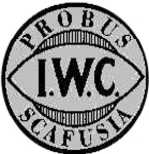
Copyright
2000
Michael
Friedberg
PastTime
All
rights reserved

Back to top of page | Return to Time Zone Home Page
Copyright © 1998-2000 Ashford Buying Co. Inc., All Rights Reserved
E-mail: info@TimeZone.com
 Kurt Klaus, a self-effacing man with a certain professorial
look about him, may be a Swiss national treasure. He certainly is for
International Watch Company in Schaffhausen, Switzerland, where he serves as
their master watchmaker. They sometimes call him Einstein at the factory. He
does look like the quintessential inventor --more than a bit of genius, mixed with a sense of
analytic precision but an ability to dream.
Kurt Klaus, a self-effacing man with a certain professorial
look about him, may be a Swiss national treasure. He certainly is for
International Watch Company in Schaffhausen, Switzerland, where he serves as
their master watchmaker. They sometimes call him Einstein at the factory. He
does look like the quintessential inventor --more than a bit of genius, mixed with a sense of
analytic precision but an ability to dream. To
understand Kurt Klaus, one needs to understand his inventions. To learn more
about Klaus' invention of the perpetual calendar for the DaVinci,
To
understand Kurt Klaus, one needs to understand his inventions. To learn more
about Klaus' invention of the perpetual calendar for the DaVinci,  A
7-day automatic or self-winding movement requires more space. The mainspring is
longer and the barrel is bigger. To wind the watch quickly, a larger oscillating
weight (that is, rotor) is required. Unlike other companies that have 7-day
manual wind movements, which usually require lengthy winding, an automatic
movement after a start can wind itself. The end result of this would be perhaps
the world's largest automatic watch movement.
A
7-day automatic or self-winding movement requires more space. The mainspring is
longer and the barrel is bigger. To wind the watch quickly, a larger oscillating
weight (that is, rotor) is required. Unlike other companies that have 7-day
manual wind movements, which usually require lengthy winding, an automatic
movement after a start can wind itself. The end result of this would be perhaps
the world's largest automatic watch movement. Of course, each of these decisions
prompted still further
decisions. The winding system adopted Pellaton's ingenious Cal. 85 invention,
with its heart-shaped cam. This simple and ingenious system has been praised for
its efficiency and reliability. Instead of having a series of gears connect the
rotor to the barrel wheel, a cam oscillates between two rollers (depicted at
right in red). This energy is transported to two clicks (depicted in yellow)
which ratchet against the barrel teeth, winding the the mainspring inside the
barrel.
Of course, each of these decisions
prompted still further
decisions. The winding system adopted Pellaton's ingenious Cal. 85 invention,
with its heart-shaped cam. This simple and ingenious system has been praised for
its efficiency and reliability. Instead of having a series of gears connect the
rotor to the barrel wheel, a cam oscillates between two rollers (depicted at
right in red). This energy is transported to two clicks (depicted in yellow)
which ratchet against the barrel teeth, winding the the mainspring inside the
barrel. The
movement's lengthy autonomy
required either double barrels or a huge barrel with a lengthy mainspring --the
design team chose the latter, on the principle that simplicity should enhance
reliability. However, the decision to use a huge
barrel required further decisions. The end of the mainspring glides inside the
barrel or, as Klaus stated, the barrel is "used" by the friction of
gliding, which means that the inside of the barrel wall wears down gradually
over years of use as the mainspring bridal slides along from its wound force. A bigger mainspring creates more "use" and more danger to the
barrel. The Calibre 5000's mainspring and barrel are depicted right, in
comparison to a normal spring and barrel.
The
movement's lengthy autonomy
required either double barrels or a huge barrel with a lengthy mainspring --the
design team chose the latter, on the principle that simplicity should enhance
reliability. However, the decision to use a huge
barrel required further decisions. The end of the mainspring glides inside the
barrel or, as Klaus stated, the barrel is "used" by the friction of
gliding, which means that the inside of the barrel wall wears down gradually
over years of use as the mainspring bridal slides along from its wound force. A bigger mainspring creates more "use" and more danger to the
barrel. The Calibre 5000's mainspring and barrel are depicted right, in
comparison to a normal spring and barrel. Albert Pellaton had developed a barrel for IWC's Calibre 853 in the late
1950s using aluminum oxide, an aluminum alloy treated with electric oxidation
and which had the same hardness as a ruby. It had worked flawlessly, with easy
glide of the mainspring and virtually no wear (in contrast, earlier Cal. 852
barrels are routinely replaced with Cal. 853 barrels during servicing). IWC's
new Calibre 5000 would have an aluminum oxide barrel. But that, in turn,
required a separate barrel head. It was very difficult to mill teeth in aluminum
oxide, so brass was used and screwed on the top of the barrel.
Albert Pellaton had developed a barrel for IWC's Calibre 853 in the late
1950s using aluminum oxide, an aluminum alloy treated with electric oxidation
and which had the same hardness as a ruby. It had worked flawlessly, with easy
glide of the mainspring and virtually no wear (in contrast, earlier Cal. 852
barrels are routinely replaced with Cal. 853 barrels during servicing). IWC's
new Calibre 5000 would have an aluminum oxide barrel. But that, in turn,
required a separate barrel head. It was very difficult to mill teeth in aluminum
oxide, so brass was used and screwed on the top of the barrel. While the
winding system and the barrel were based on IWC's Cal. 85 designs, as originally
developed by Albert Pellaton during the late 1940s through the 1950s, the
escapement of the new movement would be based on IWC's Calibre 89. This
ultra-reliable manual movement was introduced by IWC shortly after World War II
and continued for more than 40 years. Klaus wanted to use what he considered the
"best of IWC". IWC's famous Mark XI watch used the Calibre 89 and the
military issue Mark XI's were all chronometers. According to Klaus, if was good
enough for pilot watches, it was good enough for the new Calibre 5000.
While the
winding system and the barrel were based on IWC's Cal. 85 designs, as originally
developed by Albert Pellaton during the late 1940s through the 1950s, the
escapement of the new movement would be based on IWC's Calibre 89. This
ultra-reliable manual movement was introduced by IWC shortly after World War II
and continued for more than 40 years. Klaus wanted to use what he considered the
"best of IWC". IWC's famous Mark XI watch used the Calibre 89 and the
military issue Mark XI's were all chronometers. According to Klaus, if was good
enough for pilot watches, it was good enough for the new Calibre 5000. The
Calibre 5000 therefore adopted the pocketwatch principle of a larger escapement
and correspondingly larger balance. However, because Klaus considered the Cal.
89 escapement as difficult to regulate, he took the regulator design from the
Cal. 8541. The regulation still does not appear simple. The screwed balance was
used partially for appearance, but it allows first adjustments (such as if the
watch initially is one minute fast) and positional adjustment. Eccentric pins,
not screws, on the regulator are primarily used to adjust beat. The spring must
be perfectly centered.
The
Calibre 5000 therefore adopted the pocketwatch principle of a larger escapement
and correspondingly larger balance. However, because Klaus considered the Cal.
89 escapement as difficult to regulate, he took the regulator design from the
Cal. 8541. The regulation still does not appear simple. The screwed balance was
used partially for appearance, but it allows first adjustments (such as if the
watch initially is one minute fast) and positional adjustment. Eccentric pins,
not screws, on the regulator are primarily used to adjust beat. The spring must
be perfectly centered. Unlike
most other movements, the Calibre 5000 has a power reserve with a
mechanism to stop the balance, as the spring becomes close to fully unwound. The
amount of winding goes through a gear train and as the indicator approaches 7
days of unwind it triggers a pin on a wheel. A "differential stop
spring" then serves as a brake on the balance. When I asked whether any
other watch incorporated such a clever design, Herr Klaus said only one:
"the Lange Pour le Merit, but that differential stop spring stops the
cage of the tourbillon". When I asked whether stopping the balance could be
bad for a watch, as some other companies contend, he just shook his head,
"I've never seen danger in 50 years" and pointed out the reliability
of IWC's Calibre 89.
Unlike
most other movements, the Calibre 5000 has a power reserve with a
mechanism to stop the balance, as the spring becomes close to fully unwound. The
amount of winding goes through a gear train and as the indicator approaches 7
days of unwind it triggers a pin on a wheel. A "differential stop
spring" then serves as a brake on the balance. When I asked whether any
other watch incorporated such a clever design, Herr Klaus said only one:
"the Lange Pour le Merit, but that differential stop spring stops the
cage of the tourbillon". When I asked whether stopping the balance could be
bad for a watch, as some other companies contend, he just shook his head,
"I've never seen danger in 50 years" and pointed out the reliability
of IWC's Calibre 89.
